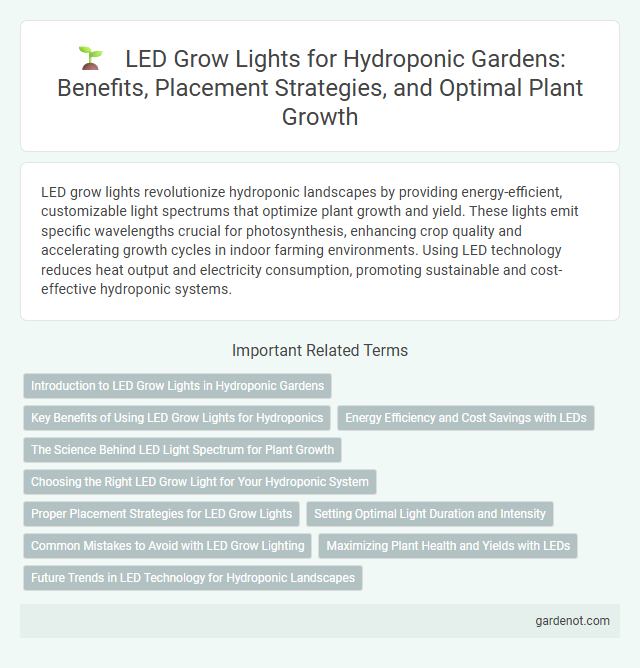LED grow lights revolutionize hydroponic landscapes by providing energy-efficient, customizable light spectrums that optimize plant growth and yield. These lights emit specific wavelengths crucial for photosynthesis, enhancing crop quality and accelerating growth cycles in indoor farming environments. Using LED technology reduces heat output and electricity consumption, promoting sustainable and cost-effective hydroponic systems.
Introduction to LED Grow Lights in Hydroponic Gardens
LED grow lights are essential components in hydroponic gardens, providing targeted light spectra that promote plant growth and development. These energy-efficient lights emit specific wavelengths tailored to photosynthesis, improving crop yield and quality while reducing electricity costs. Advanced LED technology enables precise control over light intensity and duration, optimizing growth cycles for various hydroponic crops such as lettuce, herbs, and tomatoes.
Key Benefits of Using LED Grow Lights for Hydroponics
LED grow lights provide energy-efficient, targeted light spectrums that enhance photosynthesis and promote faster plant growth in hydroponic systems. These lights produce minimal heat, reducing the risk of plant stress and allowing for closer placement to crops, which optimizes space and light penetration. Their long lifespan and low power consumption contribute to cost savings and sustainable indoor farming operations.
Energy Efficiency and Cost Savings with LEDs
LED grow lights in hydroponic landscapes deliver superior energy efficiency compared to traditional lighting systems by converting more electricity into usable light, significantly reducing power consumption. Their long lifespan and minimal heat output lower maintenance and cooling costs, resulting in substantial cost savings over time. Utilizing energy-efficient LEDs enhances sustainable crop production while optimizing operational budgets for hydroponic growers.
The Science Behind LED Light Spectrum for Plant Growth
LED grow lights emit specific wavelengths of light that correspond to the photosynthetically active radiation (PAR) spectrum, crucial for maximizing photosynthesis and plant development in hydroponic systems. Red and blue light wavelengths, typically around 660 nm and 450 nm respectively, are most effective in stimulating chlorophyll production, influencing flowering, and promoting vegetative growth. Advances in LED technology enable customizable light spectra to optimize plant morphology, increase biomass, and improve crop yields in controlled environment agriculture.
Choosing the Right LED Grow Light for Your Hydroponic System
Selecting the ideal LED grow light for a hydroponic system involves considering light spectrum, intensity, and energy efficiency tailored to specific plant needs. Full-spectrum LED grow lights mimic natural sunlight, promoting photosynthesis and healthy growth in leafy greens, herbs, and flowering plants. Energy-efficient models reduce electricity costs while providing optimal PAR (Photosynthetically Active Radiation) levels crucial for maximizing crop yield and quality in controlled environments.
Proper Placement Strategies for LED Grow Lights
Proper placement of LED grow lights in hydroponic landscapes ensures optimal light penetration and uniform plant growth, typically positioning lights 12 to 24 inches above the canopy depending on the light intensity and plant type. Utilizing adjustable mounting systems allows precise control over light distance and angle, maximizing photosynthesis efficiency while minimizing energy consumption. Strategic spacing based on light footprint and crop density prevents shadowing and promotes consistent development across all plants.
Setting Optimal Light Duration and Intensity
Setting optimal light duration and intensity for LED grow lights in hydroponic landscapes maximizes photosynthesis efficiency and promotes robust plant growth. Tailoring light schedules between 12 to 16 hours per day, with intensities ranging from 200 to 600 mmol/m2/s depending on the plant species, ensures energy-efficient growth and minimizes stress. Monitoring light spectrum and intensity using PAR meters helps maintain ideal conditions for nutrient uptake and foliage development.
Common Mistakes to Avoid with LED Grow Lighting
Using LED grow lights incorrectly can hinder plant growth in hydroponic landscapes; common mistakes include improper light spectrum selection, inadequate distance between lights and plants, and insufficient photoperiod control. Overexposure to intense light can cause leaf burn, while underexposure leads to weak, leggy plants. Ensuring the right balance of red and blue wavelengths and adjusting light duration according to plant growth stages are crucial for optimal photosynthesis and healthy development.
Maximizing Plant Health and Yields with LEDs
LED grow lights provide precise light spectra tailored to specific plant growth stages, enhancing photosynthesis efficiency in hydroponic systems. By delivering consistent, energy-efficient illumination, LEDs reduce heat stress and promote robust root development, crucial for maximizing yields. Optimizing light intensity and duration with advanced LED technology ensures healthier plants and higher crop productivity in hydroponic landscapes.
Future Trends in LED Technology for Hydroponic Landscapes
Future trends in LED technology for hydroponic landscapes include advancements in full-spectrum lighting and energy efficiency, enabling optimized plant growth and reduced operational costs. Integration of smart sensors and AI-driven light modulation allows precise control over light intensity and spectrum, tailored to specific plant species and growth stages. Emerging innovations focus on miniaturized, customizable LEDs that enhance photosynthesis while minimizing heat output, promoting sustainable urban agriculture.
LED grow light Infographic

 gardenot.com
gardenot.com